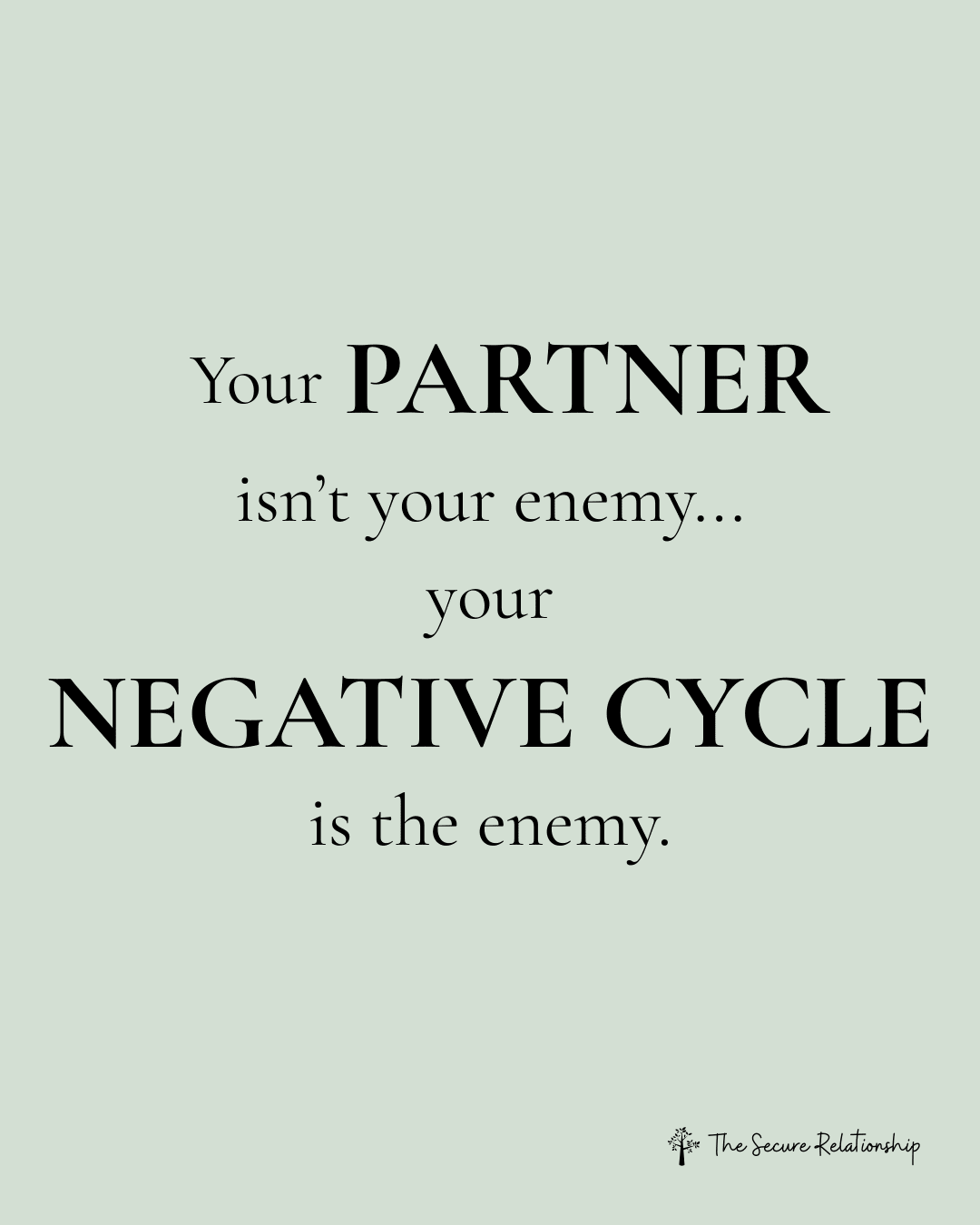Your Partner Isn’t the Enemy—Your Negative Cycle Is
Your Partner Isn’t the Enemy—Your Negative Cycle Is
Negative cycles are repetitive patterns of conflict that leave both partners feeling:
Unheard
Misunderstood
Invalidated
Emotionally disconnected
These cycles create unresolved tension and emotional distance, and over time, can do real damage to the relationship if left unchecked.
You’re not fighting each other. You’re both caught in a pattern—and the pattern is the enemy.
What Most Negative Cycles Look Like:
The anxiously attached partner brings up a concern—often with blame, protest, or emotional intensity.
The avoidantly attached partner responds with defensiveness, minimization, or logic.
The anxious partner feels dismissed and gets more emotionally escalated, trying harder to be heard.
The avoidant partner feels attacked, and pulls away further—deflecting, appeasing, or shutting down.
Distance grows. Eventually, the loneliness peaks and they reconnect.
A new concern arises... and the cycle starts all over again.
Unchecked Negative Cycles Can:
Create chronic emotional disconnection
Erode trust and safety
Increase resentment and hopelessness
Become more intense over time
Lead to long-term relationship damage
Healing begins when cycles are:
Less frequent
Less intense
Repaired more quickly and more fully
Common Ways Anxious Partners Contribute to the Cycle:
Over-contaminating the relationship with personal and relational anxiety
Regulating emotions by trying to control external behaviors (emotional abandonment of self)
Hyper-focusing on what’s wrong
Alternating between blaming partner and blaming self (but leaning toward blame of partner)
Expressing needs with protest, blame, or emotional escalation
Dismissing or invalidating their partner’s perspective
Struggling to “take turns” in conflict
Common Ways Avoidant Partners Contribute to the Cycle:
Creating an emotionally disengaged and unresponsive relationship environment
Regulating emotions by disengaging from self and others (emotional self-abandonment)
Ignoring concerns until pressure builds
Alternating between blaming self and partner (but leaning toward self-blame)
Struggling to recognize or assert their own attachment needs
Invalidating their partner’s concerns or emotions
Struggling to “take turns” in conflict
So What Does Healing Look Like?
Healing happens when the pattern slows down, and partners learn new ways of connecting:
Naming deeper emotions underneath anger (fear, shame, sadness, loneliness)
Taking time to understand each other without needing agreement
Validating one another’s inner experiences
Asserting needs from a place of self, not accusation
e.g. “My sadness needs comfort right now” instead of “You only care about fixing things.”
Each partner emotionally engaging—with themselves and with each other
Not Every Couple Heals the Same Way
Some couples:
Learn how to shift the cycle naturally, without knowing what to call it
Use self-help tools to interrupt the cycle
Need support from a trained professional
Carry attachment wounds so deep they need extended help to unpack
And sometimes, despite best efforts, healing doesn’t happen. Some couples may need to consider other options. That doesn’t mean they’ve failed—it means they’re making space for the truth.
All negative cycles are co-created.
Some partners contribute more. Some are more willing to change.
But no one creates or continues a negative cycle on their own.
Support for Healing Negative Cycles
Attachment 101 Course – Learn how attachment styles feed into recurring patterns
Relationship Coaching – Work with a coach trained in Emotionally Focused approaches to interrupt the cycle
Understanding Shame Workshop – Explore how shame contributes to emotional reactivity
Couple and Individual Group – Practice naming and interrupting negative cycles in real-time with support
Julie’s Picture Book with Quick Tips – Keep powerful reminders close at hand when the cycle starts to spin
“Your partner isn’t the problem. The pattern between you is.”


Trying to control your environment—like keeping a spotless house—can sometimes be a way to manage inner anxiety caused by relationship disconnection. But when that strategy backfires, it can create more of the very disconnection you’re trying to avoid. This post explores how personal anxiety shows up in relationships, and how couples can break the cycle.